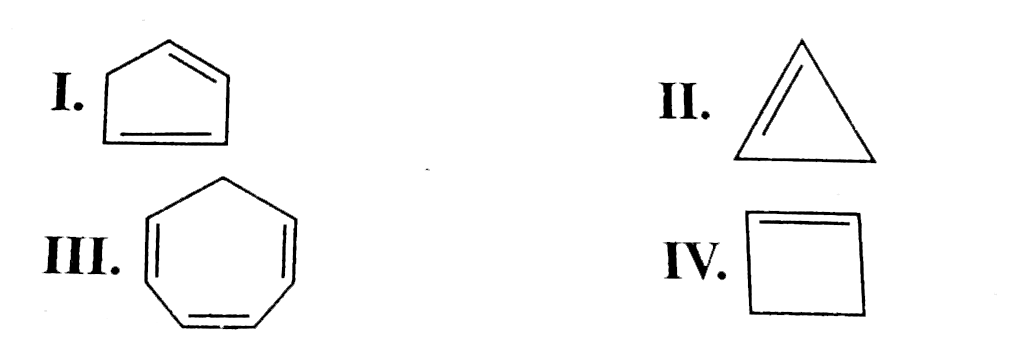The decreasing size of K+,Ca2+,Cl−&S2− follows the order:
K+>Ca+2>S−2>Cl−
K+>Ca+2>Cl−>S−2
Ca+2>K+>Cl−>S−2
S−2>Cl−>K+>Ca+2
The correct Answer is:D
To determine the decreasing size of the ions K+,Ca2+,Cl−, and S2−, we need to analyze their properties as isoelectronic species and how their ionic charges affect their sizes.
1. Identify the number of electrons in each ion:
- K+: Potassium (K) has an atomic number of 19. When it loses one electron to form K+, it has 18 electrons.
- Ca2+: Calcium (Ca) has an atomic number of 20. When it loses two electrons to form Ca2+, it also has 18 electrons.
- Cl−: Chlorine (Cl) has an atomic number of 17. When it gains one electron to form Cl−, it has 18 electrons.
- S2−: Sulfur (S) has an atomic number of 16. When it gains two electrons to form S2−, it has 18 electrons.
All these ions are isoelectronic, meaning they have the same number of electrons (18 electrons).
2. Consider the effect of ionic charge on size:
- In isoelectronic species, the size of the ions is influenced by their nuclear charge (the number of protons in the nucleus).
- A higher positive charge (more protons) means a stronger attraction between the nucleus and the electrons, resulting in a smaller ionic size.
- Conversely, a higher negative charge means a weaker attraction, leading to a larger ionic size.
3. Analyze the charges of the ions:
- K+ has a +1 charge (19 protons).
- Ca2+ has a +2 charge (20 protons).
- Cl− has a -1 charge (17 protons).
- S2− has a -2 charge (16 protons).
4. Rank the ions based on size:
- Ca2+ (smallest) < K+ < Cl− < S2− (largest)
- This is because Ca2+ has the highest positive charge, pulling the electrons closer and making it smaller. S2− has the highest negative charge, leading to a larger size.
5. Final order of decreasing size:
- The order of decreasing size is S2−>Cl−>K+>Ca2+.
Final Answer:
The decreasing size of K+,Ca2+,Cl−, and S2− follows the order:
S2−>Cl−>K+>Ca2+
- K+: Potassium (K) has an atomic number of 19. When it loses one electron to form K+, it has 18 electrons.
- Ca2+: Calcium (Ca) has an atomic number of 20. When it loses two electrons to form Ca2+, it also has 18 electrons.
- Cl−: Chlorine (Cl) has an atomic number of 17. When it gains one electron to form Cl−, it has 18 electrons.
- S2−: Sulfur (S) has an atomic number of 16. When it gains two electrons to form S2−, it has 18 electrons.
- In isoelectronic species, the size of the ions is influenced by their nuclear charge (the number of protons in the nucleus).
- A higher positive charge (more protons) means a stronger attraction between the nucleus and the electrons, resulting in a smaller ionic size.
- Conversely, a higher negative charge means a weaker attraction, leading to a larger ionic size.
- K+ has a +1 charge (19 protons).
- Ca2+ has a +2 charge (20 protons).
- Cl− has a -1 charge (17 protons).
- S2− has a -2 charge (16 protons).
- Ca2+ (smallest) < K+ < Cl− < S2− (largest)
- This is because Ca2+ has the highest positive charge, pulling the electrons closer and making it smaller. S2− has the highest negative charge, leading to a larger size.
- The order of decreasing size is S2−>Cl−>K+>Ca2+.
The decreasing size of K+,Ca2+,Cl−, and S2− follows the order:
S2−>Cl−>K+>Ca2+
Topper's Solved these Questions
Similar Questions
Consider the ioselectronic series , K⊕,S2−,Clɵ,Ca2+, the radii of the ions decrease as
View SolutionArrange the following in the order of their increasing size : Cl−,S2−,Ca2+,Ar
View SolutionIn the iso-electronic series :
K+,Cl−,S2−,Ca2+, the largest size is of
View SolutionThe size of species I,I+ and Iɵ decrease in the order.
View SolutionGive the decreasing order of Ka value of the following compounds.

View SolutionArrange with explanation the following ions in the increasing order of their sizes.
Cl−,N3−,O2−,S2−,Al3+
View SolutionArrange the following in the given order
(a) Decreasing ionic size, Mg2+,O2−,Na⊕,Fɵ
(b )Increasing first ionisaiton energy :Mg,Al,Si,Na
(c ) Increasing bond length F2,N2,Cl2,O2
(d) The order of their increasing size:
Clɵ,S2−,Ca2+,Al3+
View SolutionArrange the following in the given order
(a) Decreasing ionic size, Mg2+,O2−,Na⊕,F⊕
(b) Increasing bond length F2,N2,Cl2O2
View SolutionArrange the following ions in the increasing order of their size: Be2+,CI−,S2−,Na+,Mg2+,Br−1?
View SolutionArrange the following ions in the increasing order of their size: Be2+,CI−,S2−,Na+,Mg2+,Br−1?
View Solution
